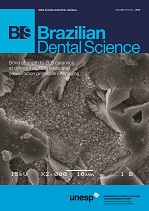Prevalence of oral mucosal status in resident and non-resident nursing home in Isfahan city, Iran: a comparative cross-sectional study
DOI:
https://doi.org/10.14295/bds.2019.v22i4.1750Abstract
Objective: The aim of this study was to evaluate the oral mucosal status of residents nursing home and non-resident in Isfahan, Iran and compare them with each other. Material and Methods: This was a cross-sectional study comparing 281 elderly in two groups: 141 resident and 140 non-residents nursing homes in Isfahan, Iran. The selection of nursing home and all of elderly was randomly. The nonresidents elderly were randomly selected from the public places adjacent to the nursing home. Persons were examining and the relevant information recorded in a checklists. Data were analyzed by SPSS version 24 using t-test, chi square, Mann- Whitney, Fisher exact test. (?=0/05). Results: The sample of the case was 281 people, including 135 males (48%) and 146 females (52%). Of all the subjects 153 patients (54.4%) had at least one oral lesion, 78 (55.3%) in resident nursing home and 75 (53.6%) in non-resident. There was no significant difference between two groups based on Chi-Square test (P>0/05). In this study, 25 different types of lesions were recorded, the most common lesion in all participants was epulis fissuratum (12.1%). Conclusion: The results showed that the prevalence of mucosal lesions is high in the elderly living in the centers and in the non-resident. Therefore, maintaining dentures is necessary to prevent and control lesions.
Keywords
Lesion; Mouth mucosa; Elderly; Nursing home; Cross-sectional study.
Downloads
Downloads
Additional Files
Published
How to Cite
Issue
Section
License
Brazilian Dental Science uses the Creative Commons (CC-BY 4.0) license, thus preserving the integrity of articles in an open access environment. The journal allows the author to retain publishing rights without restrictions.
=================




























